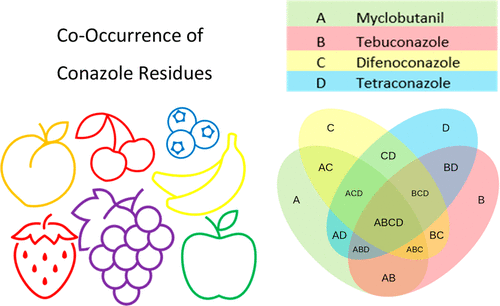当前位置:
X-MOL 学术
›
J. Agric. Food Chem.
›
论文详情
Our official English website, www.x-mol.net, welcomes your
feedback! (Note: you will need to create a separate account there.)
Co-occurrence of Conazole Fungicide Residues in Raw Agricultural Commodities Sampled by the United States Department of Agriculture Pesticide Data Program
Journal of Agricultural and Food Chemistry ( IF 5.7 ) Pub Date : 2021-10-11 , DOI: 10.1021/acs.jafc.1c04062 Arpad Z Szarka 1 , Tharacad S Ramanarayanan 1
Journal of Agricultural and Food Chemistry ( IF 5.7 ) Pub Date : 2021-10-11 , DOI: 10.1021/acs.jafc.1c04062 Arpad Z Szarka 1 , Tharacad S Ramanarayanan 1
Affiliation

|
In this study, the residue data for conazole fungicides were collated and analyzed in all crop samples reported by the United States Department of Agriculture Pesticide Data Program over the period of 2009–2019. Considering all individual samples, the overall detection frequencies (DFs) of conazoles are less than 13%. Among the 18 conazoles, imazalil had the highest overall DF of 6%, followed by tebuconazole and myclobutanil, with 4% each. Conazoles were detected most frequently in raisins with 28% DF, followed by cherries (frozen and fresh) and grapes, with 12, 10, and 10%, respectively. The presence of multiple conazoles in single commodity samples is very low, below 2%. The analyses found no more than four conazoles present in any given sample. Out of the 18 conazoles, 8 of them were not detected in more than 99.9% of the commodity samples from 2009 to 2019 and, therefore, can be eliminated from screening-level cumulative risk assessment for dietary contributions from food items. While conazoles are widely used on food commodities, co-occurrence of conazole residues was observed only in a very limited number of food commodities, including raisins, grapes, cherries (frozen), nectarines, and peaches. Considering the remaining individual food commodities, the co-occurrence of conazole residues in single commodity samples is very low or not even present.
中文翻译:

美国农业部农药数据计划采样的未加工农产品中康唑类杀菌剂残留的共存情况
在这项研究中,美国农业部农药数据计划在 2009-2019 年期间报告的所有作物样品中,对康唑类杀菌剂的残留数据进行了整理和分析。考虑到所有单个样品,康唑类药物的总体检测频率 (DF) 低于 13%。在这 18 种康唑类药物中,抑霉唑的总 DF 最高,为 6%,其次是戊唑醇和丁苯菌胺,各为 4%。在含 28% DF 的葡萄干中检测到康唑类化合物最为常见,其次是樱桃(冷冻和新鲜)和葡萄,分别为 12%、10% 和 10%。单一商品样品中多种康唑的含量非常低,低于 2%。分析发现,任何给定样品中都存在不超过四种康唑。在 18 种康唑中,有 8 种在 99 种以上未检出。9% 的商品样本从 2009 年到 2019 年,因此可以从食品的膳食贡献的筛选级累积风险评估中排除。虽然康唑广泛用于食品,但仅在极少数食品中观察到康唑残留的共存,包括葡萄干、葡萄、樱桃(冷冻)、油桃和桃子。考虑到剩余的单个食品商品,单一商品样品中康唑残留的共存率非常低或什至不存在。葡萄、樱桃(冷冻)、油桃和桃子。考虑到剩余的单个食品商品,单一商品样品中康唑残留的共存率非常低或什至不存在。葡萄、樱桃(冷冻)、油桃和桃子。考虑到剩余的单个食品商品,单一商品样品中康唑残留的共存率非常低或什至不存在。
更新日期:2021-10-20
中文翻译:

美国农业部农药数据计划采样的未加工农产品中康唑类杀菌剂残留的共存情况
在这项研究中,美国农业部农药数据计划在 2009-2019 年期间报告的所有作物样品中,对康唑类杀菌剂的残留数据进行了整理和分析。考虑到所有单个样品,康唑类药物的总体检测频率 (DF) 低于 13%。在这 18 种康唑类药物中,抑霉唑的总 DF 最高,为 6%,其次是戊唑醇和丁苯菌胺,各为 4%。在含 28% DF 的葡萄干中检测到康唑类化合物最为常见,其次是樱桃(冷冻和新鲜)和葡萄,分别为 12%、10% 和 10%。单一商品样品中多种康唑的含量非常低,低于 2%。分析发现,任何给定样品中都存在不超过四种康唑。在 18 种康唑中,有 8 种在 99 种以上未检出。9% 的商品样本从 2009 年到 2019 年,因此可以从食品的膳食贡献的筛选级累积风险评估中排除。虽然康唑广泛用于食品,但仅在极少数食品中观察到康唑残留的共存,包括葡萄干、葡萄、樱桃(冷冻)、油桃和桃子。考虑到剩余的单个食品商品,单一商品样品中康唑残留的共存率非常低或什至不存在。葡萄、樱桃(冷冻)、油桃和桃子。考虑到剩余的单个食品商品,单一商品样品中康唑残留的共存率非常低或什至不存在。葡萄、樱桃(冷冻)、油桃和桃子。考虑到剩余的单个食品商品,单一商品样品中康唑残留的共存率非常低或什至不存在。











































 京公网安备 11010802027423号
京公网安备 11010802027423号